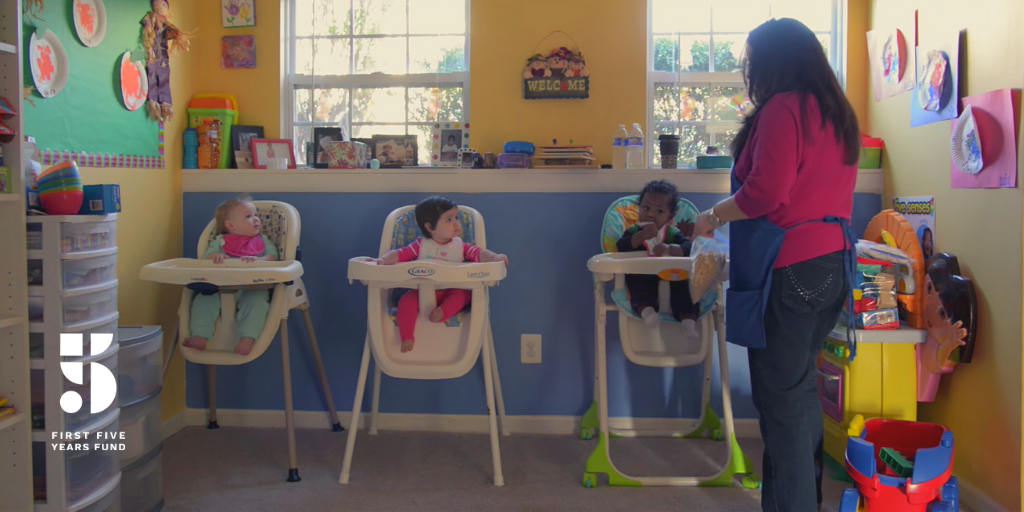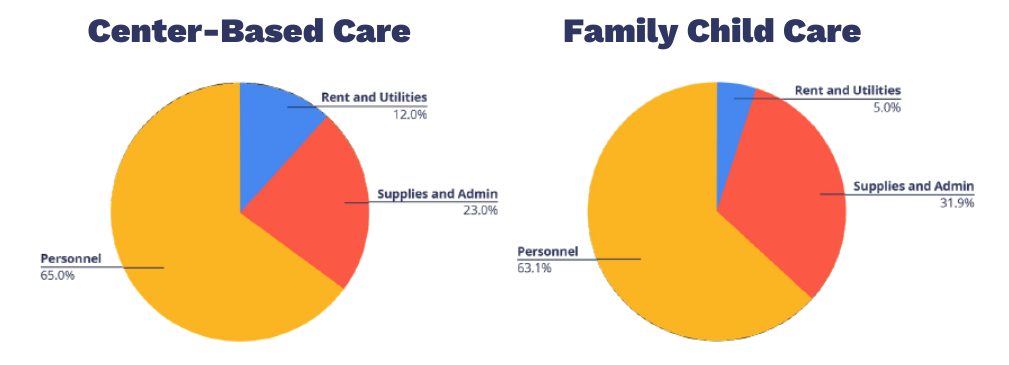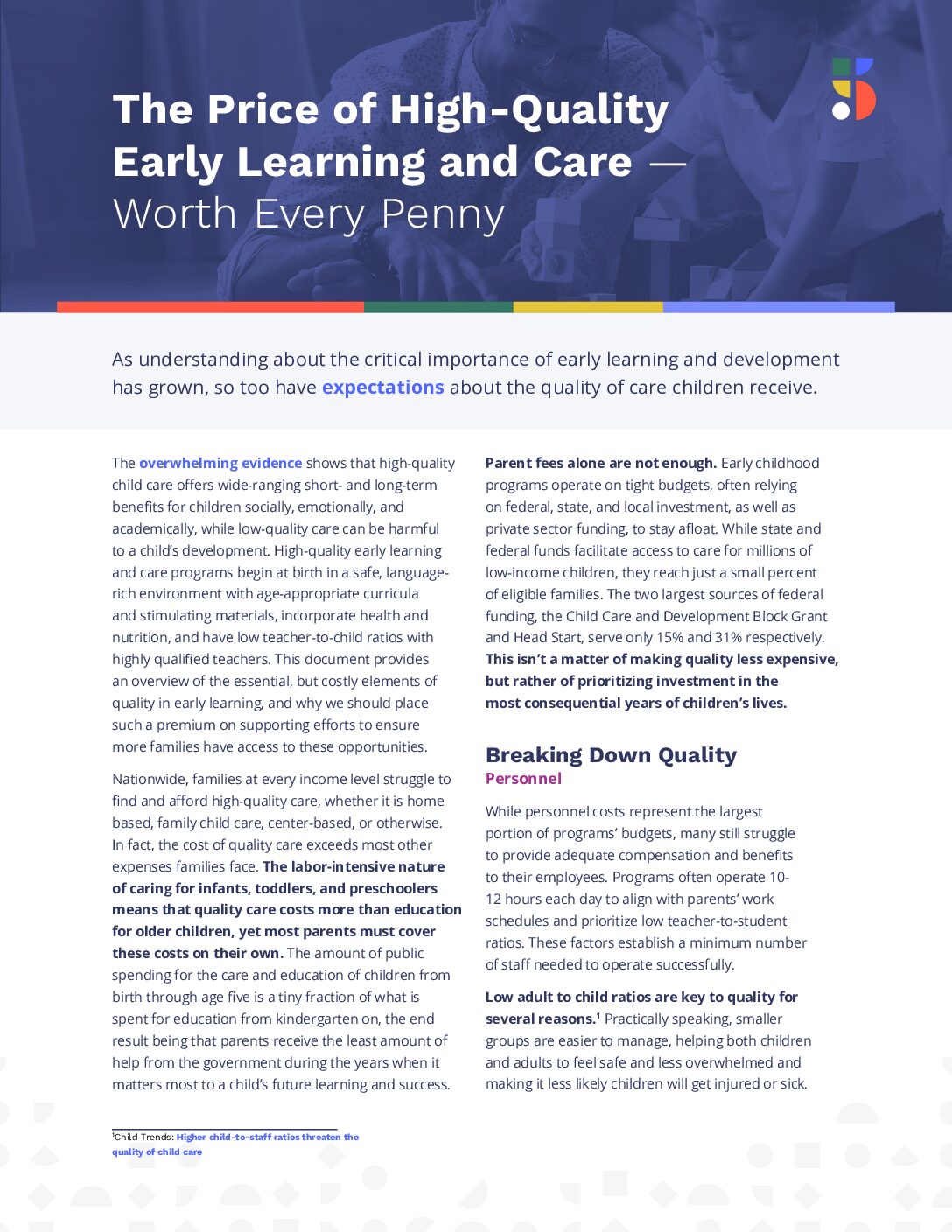The Cost of Providing High-Quality Early Learning and Care — Worth Every Penny

As understanding about the critical importance of early learning and development has grown, so too have expectations about the quality of care children receive.

The overwhelming evidence shows that high-quality child care offers wide-ranging short- and long-term benefits for children socially, emotionally, and academically, while low-quality care can be harmful to a child’s development. High-quality early learning and care programs begin at birth in a safe, language- rich environment with age-appropriate curricula and stimulating materials, incorporate health and nutrition, and have low teacher-to-child ratios with highly qualified teachers. This document provides an overview of the essential, but costly elements of quality in early learning, and why we should place such a premium on supporting efforts to ensure more families have access to these opportunities.
Nationwide, families at every income level struggle to find and afford high-quality care, whether it is home based, family child care, center-based, or otherwise. In fact, the cost of quality care exceeds most other expenses families face. The labor-intensive nature of caring for infants, toddlers, and preschoolers means that quality care costs more than education for older children, yet most parents must cover these costs on their own. The amount of public spending for the care and education of children from birth through age five is a tiny fraction of what is spent for education from kindergarten on, the end result being that parents receive the least amount of help from the government during the years when it matters most to a child’s future learning and success.
Parent fees alone are not enough. Early childhood programs operate on tight budgets, often relying on federal, state, and local investment, as well as private sector funding, to stay afloat. While state and federal funds facilitate access to care for millions of low-income children, they reach just a small percent of eligible families. The two largest sources of federal funding, the Child Care and Development Block Grant and Head Start, serve only 15% and 31% respectively.
This isn’t a matter of making quality less expensive, but rather of prioritizing investment in the most consequential years of children’s lives.
Breaking Down Quality
Personnel
While personnel costs represent the largest portion of programs’ budgets, many still struggle to provide adequate compensation and benefits to their employees. Programs often operate 10-12 hours each day to align with parents’ work schedules and prioritize low teacher-to-student ratios. These factors establish a minimum number of staff needed to operate successfully.
Low adult to child ratios are key to quality for several reasons. Practically speaking, smaller groups are easier to manage, helping both children and adults to feel safe and less overwhelmed and making it less likely children will get injured or sick.
Further, during a time of rapid brain development, low adult-child ratios help ensure children receive positive, responsive caregiving, which is extremely important to a young child’s socio-emotional growth, physical well-being, and overall learning.
Adult-child ratios of no more than 1:4 are needed for infants and toddlers who rely on their teachers for feeding and diapering, in addition to fostering their mental, physical, and emotional development. As children grow more independent, ratios of 1:8 for 3-year-olds and 1:10 for 4-year-olds allow teachers to focus on direct interactions, which promote a child’s emerging language skills and social and emotional development.
Without compromising quality by reducing the number of staff, this portion of the budget can only go so far, and because there are so many other fixed costs, to make tuition “affordable” programs reduce the cost they can control–compensation.

In 2019, the median salary for child care workers was $24,230 per year or $11.65 per hour, and most child care workers lack benefits, including health care and paid sick or vacation time. To recruit and retain highly-skilled teachers, which are integral to program quality, compensation must be sufficient to ensure a career in early childhood is sustainable and allows them to provide for their own families.
Supplies and Administration
Supplies and administrative costs represent the second largest cost for providers. This broad category includes everything from food and classroom materials to day-to-day operations costs. Recognizing that access to healthy, nutritious foods is crucial for healthy brain and physical development, many programs offer three meals a day or send home food for evenings and weekends. Additionally, children learn through play, meaning engaging and age-appropriate toys and materials are essential. Finally, many providers operate year round given the benefits for learning and parents’ ability to work or attend school, which simply means used and broken materials must be replaced more often.
Rent and Utilities
While representing the smallest share of providers’ budgets, facility-related expenses are nonetheless necessary for a high-quality program. At the most basic level, facilities must be safe, but the size and setup of the facility, both indoors and outdoors, also play an important role in providing children more space to learn and explore. High-quality and developmentally appropriate environments promote healthy behaviors, independence, and social-emotional skills in young children.
This document provides an overview of the essential, but costly elements of quality in early learning, and why we should place such a premium on supporting efforts to ensure more families have access to these opportunities.
Subscribe to FFYF First Look
Every morning, FFYF reports on the latest child care & early learning news from across the country. Subscribe and take 5 minutes to know what's happening in early childhood education.



